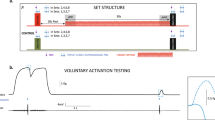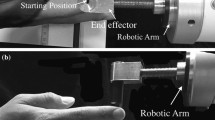Abstract
The effect of muscle fatigue on error compensation strategies during multi-finger ramp force production tasks was investigated. Thirteen young, healthy subjects were instructed to produce a total force with four fingers of the right hand to accurately match a visually displayed template. The template consisted of a 3-s waiting period, a 3-s ramp force production [from 0 to 30% maximal voluntary contraction (MVC)], and a 3-s constant force production. A series of 12 ramp trials was performed before and after fatigue. Fatigue was induced by a 60-s maximal isometric force production with either the index-finger only or with all four fingers during two separate testing sessions. The average percent of drop was 38.2% in the MVC of the index finger after index-finger fatiguing exercise and 38.3% in the MVC of all fingers after four-finger fatiguing exercise. The ability of individual fingers to compensate for each other’s errors in order for the total force to match the preset template was quantified as the error compensation index (ECI), i.e., the ratio of the sum of variances of individual finger forces and the variance of the total force. By comparing pre- and post-fatigue performance during four-finger ramp force production, we observed that the variance of the total force was not significantly changed after one- or four-finger fatiguing exercise. The ECI significantly decreased after four-finger fatiguing exercise, especially during the last second of the ramp; while the ECI remained unchanged after index finger single-finger fatiguing exercise. These results suggest that the central nervous system is able to utilize the abundant degrees of freedom to compensate for partial impairment of the motor apparatus induced by muscle fatigue to maintain the desired performance. However, this ability is significantly decreased when all elements of the motor apparatus are impaired.






Similar content being viewed by others
References
Allen TJ, Proske U (2006) Effect of muscle fatigue on the sense of limb position and movement. Exp Brain Res 170:30–38
Bernstein NA (1935) The problem of the interrelation of co-ordination and localization. Arch Biol Sci 38:1–35
Bernstein NA (1967) The co-ordination and regulation of movements. T. Pergamon Press, Oxford
Bigland-Ritchie B, Donovan EF, Roussos CS (1981) Conduction velocity and EMG power spectrum changes in fatigue of sustained maximal efforts. J Appl Physiol 51:1300–1305
Bonnard M, Sirin AV, Oddsson L, Thorstensson A (1994) Different strategies to compensate for the effects of fatigue revealed by neuromuscular adaptation processes in humans. Neurosci Lett 166:101–105
Cote JN, Mathieu PA, Levin MF, Feldman AG (2002) Movement reorganization to compensate for fatigue during sawing. Exp Brain Res 146:394–398
Danion F, Latash ML, Li ZM, Zatsiorsky VM (2000) The effect of fatigue on multifinger co-ordination in force production tasks in humans. J Physiol 523(Pt 2):523–532
Danion F, Latash ML, Li ZM, Zatsiorsky VM (2001) The effect of a fatiguing exercise by the index finger on single and multi-finger force production tasks. Exp Brain Res 138:322–329
Enoka RM, Stuart DG (1992) Neurobiology of muscle fatigue. J Appl Physiol 72:1631–1648
Evans RK, Scoville CR, Ito MA, Mello RP (2003) Upper body fatiguing exercise and shooting performance. Mil Med 168:451–456
Forestier N, Nougier V (1998) The effects of muscular fatigue on the coordination of a multijoint movement in human. Neurosci Lett 252:187–190
Forestier N, Teasdale N, Nougier V (2002) Alteration of the position sense at the ankle induced by muscular fatigue in humans. Med Sci Sports Exerc 34:117–122
Gandevia SC (2001) Spinal and supraspinal factors in human muscle fatigue. Physiol Rev 81:1725–1789
Gelfand IM, Latash ML (1998) On the problem of adequate language in motor control. Mot Control 2:306–313
Huffenus AF, Amarantini D, Forestier N (2006) Effects of distal and proximal arm muscles fatigue on multi-joint movement organization. Exp Brain Res 170:438–447
Latash ML (1996) How does our brain make its choices? In: Latash ML, Turvey MT (eds) Dexterity and its development. Erlbaum Publisher, Mahwah, NJ, pp 277–304
Latash ML (2000) There is no motor redundancy in human movements. There is motor abundance. Mot Control 4:257–259
Latash ML, Anson JG (2006) Synergies in health and disease: relations to adaptive changes in motor coordination. Phys Ther 86:1151–1160
Latash ML, Kang N, Patterson D (2002) Finger coordination in persons with down syndrome: atypical patterns of coordination and the effects of practice. Exp Brain Res 146:345–355
Latash ML, Li ZM, Zatsiorsky VM (1998b) A principle of error compensation studied within a task of force production by a redundant set of fingers. Exp Brain Res 122:131–138
Latash ML, Scholz JP, Danion F, Schöner G (2001) Structure of motor variability in marginally redundant multifinger force production tasks. Exp Brain Res 141:153–165
Latash ML, Shim JK, Zatsiorsky VM (2004) Is there a timing synergy during multi-finger production of quick force pulses? Exp Brain Res 159:65–71
Li S (2006) Perception of individual finger forces during multi-finger force production tasks. Neurosci Lett 409:239–243
Li S, Leonard CT (2006) The effect of enslaving on perception of finger forces. Exp Brain Res 172:301–309
Li ZM, Latash ML, Zatsiorsky VM (1998b) Force sharing among fingers as a model of the redundancy problem. Exp Brain Res 119:276–286
Loeve M (1977) Probability theory I. Springer, NY
Santello M, Soechting JF (2000) Force synergies for multifingered grasping. Exp Brain Res 133:457–467
Scholz JP, Danion F, Latash ML, Schoner G (2002) Understanding finger coordination through analysis of the structure of force variability. Biol Cybern 86:29–39
Scholz JP, Schoner G (1999) The uncontrolled manifold concept: identifying control variables for a functional task. Exp Brain Res 126:289–306
Scholz JP, Schoner G, Latash ML (2000) Identifying the control structure of multi-joint coordination during pistol shooting. Exp Brain Res 135:382–404
Schoner G (1995) Recent developments and problems in human movement science and their conceptual implications. Ecol Pscyhol 8:291–314
Seif-Naraghi AH, Winters JM (1990) Optimized strategies for scaling goal-directed dynamic limb movements. In: Winters JM, Woo SL-Y (eds) Multiple muscle systems: biomechanics and movement organization. Springer, NY, pp 312–334
Shim JK, Olafsdottir H, Zatsiorsky VM, Latash ML (2005) The emergence and disappearance of multi-digit synergies during force-production tasks. Exp Brain Res 164:260–270
Shinohara M, Li S, Kang N, Zatsiorsky VM, Latash ML (2003) Effects of age and gender on finger coordination in MVC and submaximal force-matching tasks. J Appl Physiol 94:259–270
Shinohara M, Scholz JP, Zatsiorsky VM, Latash ML (2004) Finger interaction during accurate multi-finger force production tasks in young and elderly persons. Exp Brain Res 156:282–292
Sparto PJ, Parnianpour M, Marras WS, Granata KP, Reinsel TE, Simon S (1997a) Neuromuscular trunk performance and spinal loading during a fatiguing isometric trunk extension with varying torque requirements. J Spinal Disord 10:145–156
Sparto PJ, Parnianpour M, Reinsel TE, Simon S (1997b) The effect of fatigue on multi-joint kinematics, coordination, and postural stability during a repetitive lifting test. J Orthop Sports Phys Ther 25:3–12
Walsh LD, Allen TJ, Gandevia SC, Proske U (2006) Effect of eccentric exercise on position sense at the human forearm in different postures. J Appl Physiol 100:1109–1116
Walsh LD, Hesse CW, Morgan DL, Proske U (2004) Human forearm position sense after fatigue of elbow flexor muscles. J Physiol 558:705–715
Acknowledgment
This study was supported in part by an NIH grant (1R15NS053442-01A1).
Author information
Authors and Affiliations
Corresponding author
Rights and permissions
About this article
Cite this article
Kruger, E.S., Hoopes, J.A., Cordial, R.J. et al. Error compensation during finger force production after one- and four-finger voluntarily fatiguing exercise. Exp Brain Res 181, 461–468 (2007). https://doi.org/10.1007/s00221-007-0942-z
Received:
Accepted:
Published:
Issue Date:
DOI: https://doi.org/10.1007/s00221-007-0942-z




